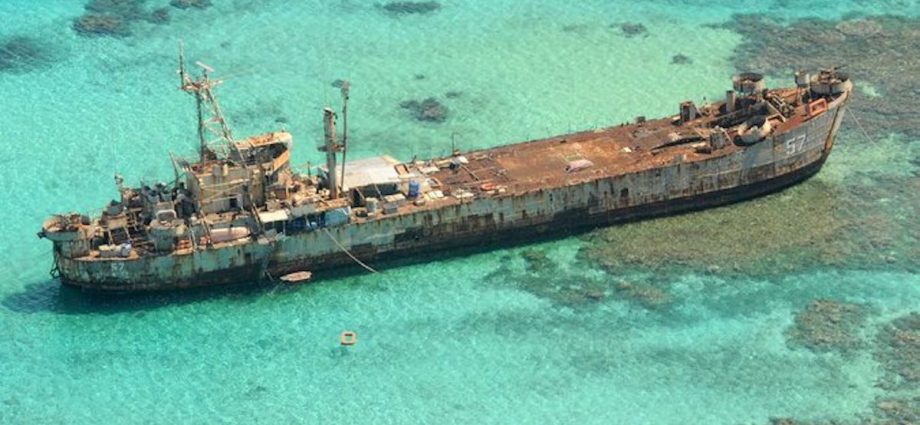
Last week, China, the Philippines and its ally the US avoided a showdown at Second Thomas Shoal in the South China Sea. How was it avoided and what happens next?
On August 5, a China Coast Guard vessel used a water cannon in an attempt to prevent Philippine government-charted boats escorted by its coast-guard vessels from delivering supplies to its troops on the purposely grounded military transport BRP Sierra Madre on Second Thomas Shoal. This was followed by widespread reporting and condemnation of China’s actions.
China also includes the submerged reef as part of its historic claim to much of the South China Sea.
Meanwhile Washington vowed to back Manila per its Mutual Defense Treaty if Philippine public vessels – including its coast guard – were attacked.
The Philippines announced it would try again, and it did so on August 23. Given the history and context, this attempt to deliver supplies was a challenge to China. A confrontation seemed imminent. Something had to give – and it did.
Two Philippine Coast Guard vessels accompanied the chartered navy-crewed civilian boats carrying the supplies. Despite China’s strenuous verbal warnings and aggressive behavior, this mission was successful.
During the event, a US surveillance plane flew overhead. A China Coast Guard radio operator warned the Philippine Coast Guard vessels to leave or “bear full responsibility for all the consequences.”
This threat was ominous because China’s coast guard is now authorized by Beijing to “use all necessary means including weapons to enforce China’s maritime claims.”
The China Coast Guard vessels repeatedly crossed the bows at close range of the Philippine vessels and then blocked them from approaching the shoal. Nevertheless, the shallow-draft supply vessels were able to outmaneuver them and succeeded in delivering the supplies.
The Philippines stated that the mission was an exercise of its “sovereignty, sovereign rights and jurisdiction within our maritime zones [and] not subject to any other country’s approval.”
The Philippines had invited a group of journalists to join the mission as part of its new strategy to expose China’s aggressive actions. They dutifully sensationalized the event, which was widely reported and condemned in the West.
So what changed to avoid a confrontation between the protagonists?
Game of chicken continues
China claimed that it allowed the supply boats to proceed “in the spirit of humanism, since the vessels were not carrying ‘illegal’ construction materials.” It called this a “special temporary arrangement.” But some thought that China was purposely showing some restraint compared with the August 5 incident because of the international outcry that followed that earlier event.
It is not clear whether the supply vessels were allowed to pass or they outmaneuvered the China Coast Guard. If the latter, Beijing is rationalizing the result. It did demonstrate its control of the area in that the Chinese vessels did not leave until after the Philippine Coast Guard vessels had left.
Even if China showed relative restraint this time, was this a one-off exception or a new “status quo”?
Neither China nor the Philippines is likely to accept the status quo, and this game of chicken is certainly not over.
The problem for the Philippines is that the feature is on its shelf and in its exclusive economic zone (EEZ) and to accept the new “status quo” would mean that it is implicitly recognizing China’s claim. Because the shoal is submerged, China’s recognition of the Philippine claim would negate its historic claim to much of the South China Sea.
After the August 23 incident, China called again for the Philippines to honor its “promise” to remove the BRP Sierra Madre. The Philippines denied it ever made such a promise and pointed out that the presence of the grounded vessel was part of the status quo.
As if throwing down the gauntlet, Philippines Armed Forces chief General Romeo Brawner Jr said he was considering making improvements to the dilapidated ship grounded on the Shoal, an action China vehemently opposes.
The potential for a showdown involving the US still exists. The Philippines has publicly announced that the missions will continue “on a regular basis,” every few weeks. After the August 23 incident, the commander of the US Pacific Fleet, Admiral Samuel Paparo, said the US is prepared to assist the Philippines if China interferes with Manila’s efforts to resupply its forces on its grounded naval ship on the Shoal.
The commander of the Seventh Fleet, Vice-Admiral Karl Thomas, said China’s behavior must be challenged and checked. He said, “My forces are out here for a reason,” and assured the Philippines of backing “in the face of shared challenges.”
On the heels of the last incident, the US, the Philippines and Australia held a joint exercise in the South China Sea.
Joint patrols would be the next step up in this game of chicken. The Philippines has asked the US to join such patrols and it is apparently planning to do so. Australia also seems ready to join the Philippines in joint patrols. The first may well be near Second Thomas Shoal. If the US does join in a patrol, it will probably use a coast-guard vessel.
What happens next is anyone’s guess – perhaps water cannon and maneuvering contests between coast guards. This would be the top rung on the “gray” scale and could easily and quickly transition into a use of navy ships by both sides.
Warmongers are calling for the US to back up its words with action. The US seems to be counting on the Philippines not to escalate the situation, or if it does, on China backing down because of the US threat. This could well be a miscalculation.
This convergence of tactical trajectories may well lead to a showdown at Second Thomas Shoal. The next move is in the hands of the Philippines or China. Stay tuned.
An edited version of this article appeared in the South China Morning Post.

